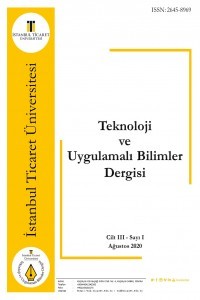Received Signal Strength Based Location Estimation for Emergency Cases
The success of the localization highly depends on the accuracy of the localization algorithm. One of the most well-known and simple localization technique is received signal strength indicator based location estimation which relies on the measuring the power level of the transmitter node. Therefore, in this study, a general framework for the localization of a victim in the harsh environments is given.
___
- Caffery, J.J. (2000). Wireless Location in CDMA Cellular Radio Systems. Boston: Kluwer Academic Publishers.
- IEEE 802.15 WPAN Task Group 4. IEEE 15-03-0489-03-004a-application-requirement-analysis-031127 v0.4. Retrieved from http://www.ieee802.org/15/pub/TG4.html
- IEEE P802.15.4a/D4 (Amendment of IEEE Std 802.15.4). (July 2006). Part 15.4: Wireless medium access control (MAC) and physical layer (PHY) specifications for low-rate wireless personal area networks (LRWPANs).
- F. C. Commission. (July 1996). Revision of the commissions rules to insure compatibility with enhanced 911 emergency calling systems. FCC Docket No. 94-102.
- Gezici, S. (Feb. 2008). A survey on wireless position estimation. Wireless Personal Communications, vol. 44, no. 3, 263–282.
- Weiss, J. (May 2004). Direct position determination of narrowband radio frequency transmitters. IEEE Signal Processing Letters, vol. 11, no. 5, 513-516.
- Qi, Y., Kobayashi, H. and Suda, H. (March 2006). Analysis of wireless geolocation in a non-line-of-sight environment. IEEE Trans. Wireless Commun., vol.5, no.3, 672-681.
- Arslan, H. and Celebi, H. (Sept. 2007). Location Information Management Systems for Cognitive Wireless Networks in Cognitive Radio Software Defined Radio, and Adaptive Wireless Systems. Springer.
- Patwari, N., Ash, J.N., Kyperountas, S., Hero, A.O., Moses, R.L. and Correal, N.S. (July 2005). Locating the nodes: Cooperative localization in wireless sensor networks. IEEE Signal Processing Mag., vol. 22, no. 4, 54-69.
- Lee, J.Y. and Scholtz, R. A. (Dec. 2002) Ranging in a dense multipath environment using an UWB radio link. IEEE J. Select. Areas Commun., vol. 20, no. 9, 1677-1683.
- Lindsey, W.C. and Simon, M.K. (1991). Phase and Doppler Measurements in Two-Way Phase-Coherent Tracking Systems. New York: Dover.
- Cong, L., and Zhuang, W. (July 2002). Hybrid TOA/AOA mobile user location for wideband CDMA cellular systems. IEEE Trans. Wireless Commun., vol. 1, no. 3, 439-447.
- Catovic, and Sahinoglu, Z. (Oct. 2004). The Cramer-Rao bounds of hybrid TOA/RSS and TDOA/RSS location estimation schemes. IEEE Communications Letters, vol. 8, 626-628.
- Reza, R.I. (2000) Data fusion for improved TOA/TDOA position determination in wireless systems. Ph.D. Dissertation, Virginia Tech.
- Nerguizian, C., Despins, C., and Affes, S. (Sept. 2001). Framework for indoor geolocation using an intelligent system. In Proc. 3rd IEEE Workshop on Wireless LANs, Newton, MA.
- Nerguizian, C., Despins, C., and Affes, S., (March 2006). Geolocation in mines with an impulse response fingerprinting technique and neural networks. IEEE Trans.Wireless Communications, vol. 5, 603-611.
- Ganesh, R., Kota, S.L., Pahlavan, K., and Agusti, R. (2005). Emerging Location Aware Broadband Wireless Ad Hoc Networks. Springer.
- Zeimpekis, V., Giaglis, G., and Lekakos, G. (2002). A Taxonomy of Indoor and Outdoor Positioning Techniques for Mobile Location Services. ACM SIGecom Exchanges, vol. 3, no. 4, 19–27.
- Trevisani, E. and Vitaletti, A. (Dec. 2004). Cell-ID Location Technique, Limits and Benefits:an Experimental Study. In Proc. 6th IEEE Workshop on Mobile Computing Systems & Applications, English Lake District, UK, 51–60.
- Rappaport, T.S. (2002). Wireless Communications: Principles and Practice. Upper Saddle River, NJ: Prentice Hall.
- Arslan, H., and Yarkan, S. (Sept. 2007). Enabling Cognitive Radio via Sensing, Awareness, and Measurements. In Cognitive Radio, Software Defined Radio, and Adaptive Wireless Systems, Springer.
- Hata, M. (1980). Empirical formula for propagation loss in land mobile radio services. IEEE Transactions on Vehicular Technology, 29(3).
- Erceg, V., Greenstein, L.J., Tjandra, S.Y., Parkoff, S.R., Gupta, A., Kulic, B., Julius, A.A., and Bianchi, R. (1999). An empirically based path loss model for wireless channels in suburban environments. IEEE J. Select.Areas Commun., vol. 17, 1205–1211.
- Parsons, J.D. (1992). The Mobile Radio Propagation Channel. New York: Halsted.
- Stuber, G.L. (1996). Principles of Mobile Communications. Kluwer Academic Publishers, Dordrecht, The Netherlands, 4th edition.
- Lee, Y.H., and Meng, Y.S. (Nov. 2007). Tropical weather effects on foliage propagation. In Proc. Second European Conf. Antennas Propag.(EuCAP 2007), Edinburgh, UK.
- Yayın Aralığı: Yılda 2 Sayı
- Başlangıç: 2018
- Yayıncı: İstanbul Ticaret Üniversitesi
Sayıdaki Diğer Makaleler
CITTASLOW-SAKİN ŞEHİRLERDE YAŞANABİLİRLİK ÜZERİNE BİR ARAŞTIRMA
KENTSEL DÖNÜŞÜM SÜRECİNDE İSTANBUL FENERBAHÇE BÖLGESİNDE ÜRETİLEN KONUTLARIN CEPHE TASARIMLARI
David LEDO HERNANDEZ, Özgür ÇENGEL
Alieu Khama BADJIE, Muammer KALYON
KURUMLARIN AÇTIĞI KAMULAŞTIRMA BEDEL TESPİT DOSYALARINA İLİŞKİN BİR İNCELEME
ROTTERDAM, KOP VAN ZUID KENTSEL DÖNÜŞÜM PROJESİ
BİNA SİRKÜLASYON ALANLARINDA İÇ MEKÂN VE YAKIN ÇEVRESİ ERİŞİLEBİLİRLİK
